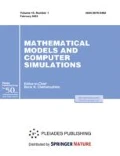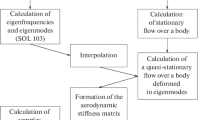Abstract
A hypersonic flow over an axisymmetric aircraft is numerically simulated in the case of a highly underexpanded exhaust plume (jet) of the main engine. The characteristics of the boundary layer separation occurring on the aircraft’s side surface are investigated for several successive points of its takeoff path. The Mach number at the nozzle exit is 6.5. The Mach number of the incoming flow varies from 4 to 7. In this case, the Reynolds number ranges from 2.5 × 105 to 3 × 103 and the ratio of the nozzle’s exit pressure to the ambient pressure, from 350 to 5 × 104. In the case of the Mach number of the incoming flow M∞ = 4, the variation range of the pressure ratio extends to 106. Replacement of the exhaust plume with a rigid simulator is considered. Data are obtained on the pressure ratios for which a separation flow begins to form on the side surface, the recirculation zone length, and the level of pressure in it in comparison with the available empirical dependences. A significant increase of the recirculation zone in front of the exhaust plume is shown when it is replaced by a rigid simulator of the same dimensions.
Similar content being viewed by others
References
P. Carriere and M. Serieix, “Effects aerodynamique de l’eclament d’un jet de fusee,” Rech. Aerosp., No. 89, 3–30 (1962).
R. Adams, “Wind tunnel testing tecniques for gas-particle flows in rocket exhaust plumes,” AIAA Paper N66-767 (AIAA, 1966).
L. Alpinieri and R. Adams, “Flow separation due to jet pluming,” AIAA J. 4, 1865–1866 (1966).
W. F. Hinson and R. J. McGhee, “Effects of jet pluming on the static stability of five rocket models at Mach numbers of 4, 5, and 6 and static pressure rations up to 26000,” NASA TN D-4064 (1967).
R. C. Boger, H. Rosenbaum, and B. L. Reeves, “Flow field interactions induced by underexpanded exhaust plumes,” AIAA J. 10, 300–306 (1972).
A. N. Shliagun, “Interaction of strongly underexpanded supersonic jet with a hypersonic sputtered flow,” Uch. Zap. TsAGI 10 (3), 37–47 (1979).
J. M. Klineberg, T. Kubota, and L. Lees, “Theory of exhaust-plumes/boundary-layer interactions at supersonic speeds,” AIAA J. 10, 581–588 (1972).
P. K. Chang, Separation of Flow (Pergamon, Oxford, New York, 1970).
J. Erdos and A. Pallone, “Shock-boundary layer interactoin and flow separation,” Proc. Heat Transfer Fluid Mech. Inst., 239–254 (1962).
K. J. Plotkin and J. S. Draper, “Detachment of the outer shock from underexpanded rocket plumes,” AIAA J. 10, 1707–1709 (1972).
E. V. Myshenkov and V. I. Myshrnkov, “Regimes of laminar flow separation due to jet exhaust,” Fluid Dyn. 29, 103–107 (1994).
E. V. Myshenkov and V. I. Myshrnkov, “Formation of lateral separation caused by a sustainer engine jet,” Fluid Dyn. 30, 592–598 (1995).
L. G. Loytsyansky, Mechanics of Liquids and Gases (Pergamon, Oxford, 1966; Nauka, Moscow, 1987).
F. R. Menter, “Zonal two equation κ-ω turbulence models for aerodynamic flows,” AIAA Paper 93-2906 (AIAA, 1993).
J. L. Steger, “Implicit finite-difference simulation of flow about arbitrary two-dimensional geometries,” AIAA J. 16, 679–686 (1978).
A. D. Savel’ev, “The use of high order composite compact schemes for computing supersonic jet interaction with a surface,” Comput. Math. Math. Phys. 53, 1558–1570 (2013).
M. N. Mikhailovskaya and B. V. Rogov, “Monotone compact running schemes for systems of hyperbolic equatins,” Comput. Math. Math. Phys. 52, 578–600 (2012).
S. K. Lele, “Compact finite difference schemes with spectral-like resolution,” J. Comput. Phys. 102, 16–42 (1992).
A. D. Savel’ev, “On the structure of internal dissipation of composite compact schemes for gasdynamic simulation,” Comput. Math. Math. Phys. 49, 2135–2148 (2009).
Author information
Authors and Affiliations
Corresponding author
Additional information
Original Russian Text © A.D. Savel’ev, 2017, published in Matematicheskoe Modelirovanie, 2017, Vol. 29, No. 9, pp. 90–100.
Rights and permissions
About this article
Cite this article
Savel’ev, A.D. Numerical Simulation of a Hypersonic Flow over an Aircraft in a High-Altitude Active Movement Area. Math Models Comput Simul 10, 218–225 (2018). https://doi.org/10.1134/S2070048218020114
Received:
Published:
Issue Date:
DOI: https://doi.org/10.1134/S2070048218020114




